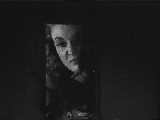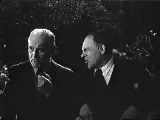(section 2)
|
THE LEECH WOMAN’s Revenge
(section 2) |
Yet explicitness is relative. I first saw these films while still in my teens and yet I must not have seen them at all. I do remember the nameless pleasure I felt when each of the female characters--"transformed" from scared to scary by extraterrestrial contact or special serum--was suddenly empowered to carry out excessive acts of vengeance. I don't recall, however, thinking specifically about the reasons for this vengeance; nor, even though I was female, do I remember feeling uncomfortable with the way these women were figured in their scared, pre-scary, state. The boys in the audience--in all likelihood simultaneously disgusted, titillated, and scared by the sight of someone the age of their mothers still radiating desire --were intending toward the moment when their fear and desire would take visible shape to prove its monstrousness. However, I, a girl still in my teens, was also directed toward that moment. Not only did I too, find it disgusting to think that my mother still "did it," but what did such an alien state as middle age have to do with me? Thus, as I watched these women, like the boys, my highly conventionalized disgust and fear was of them, not for them. Nonetheless, unlike the boys, I think I sensed the pleasure of their revenge.
Attack of the 50 Ft. Woman tells the story of Nancy, a wealthy, childless, middle aged woman unhappily married to a philanderer and prone to sloppy drinking. (We're told she's been in a private sanitarium for treatment.) After a close encounter with a (please don't laugh) "space ball" and the giant alien man within it, she collapses and is taken home to eventually--impossibly--awaken 50 feet tall in a bedroom too small to hold her. Using her bedclothes as a bra and sarong, she strides off to town and the roadhouse where her husband is romancing a younger woman (generically named "Honey"). As one shocked male bystander says to another as she passes: "She'll tear up the whole town till she finds Harry...And then she'll tear up Harry." Calling her husband's name, she pulls off the roof of the roadhouse and plucks him out, only to be killed (and to kill him) by electrocution from felled power lines. However hysterical both the 50 foot woman and the special effects, there is a sober side to this tale of a woman's humiliation and revenge. Toward the beginning of the film, as Nancy lies in her bedroom after her close encounter but before her transformation, downstairs her doctor speaks to the concerned family butler about her "wild story" and strange behavior and says: "When women reach the age of maturity, Mother Nature sometimes overworks their frustration to a point of irrationalism. Like the middle-aged man of our age who finds himself looking longingly at a girl in her early twenties."

Clip from Attack of the 50 Foot Woman
707K quicktime movie

Clip from Attack of the 50 Foot Woman
1.5MB quicktime movieIf this non-sequitur analysis makes us raise our eyebrows, consider the following from Freud, writing on obsessional neurosis in 1913:
It is well known, and has been a matter for much complaint, that women often alter strangely in character after they have abandoned their genital functions. They become quarrelsome, peevish, and argumentative, petty and miserly; in fact, they display sadistic and anal-erotic traits which were not theirs in the era of womanliness.
There is a half-truth hidden somewhere here, but it has nothing to do with some inherent postgenital transformation, and everything to do with a sense of lovelessness, a sense of being invisible and untouchable. There was a period in my middle age when I felt dried up and experienced an aridity that had nothing to do with a postmenopausal lack of vaginal lubrication. Rather, the phenomenological truth of this sense of desiccation, this "dry spell" in my affective and sexual life, was grounded in what seemed a forced exclusion from the sexual economy, from the sensual, a deprivation of the caresses from another that make one sensitive to one's own skin. Peevish, argumentative, sadistic? You bet. The desire to assert one's bodily and desiring existence knows no bounds, and is indeed 50 feet tall.
The Wasp Woman is a much simpler film; Roger Corman, who made it, went straight to the surface of the matter. The film essentially begins in an executive board room with a severely dressed and bespectacled middle-aged woman executive coldly chewing out what appear to be her male subordinates for the company's poor sales. We find out that she is Janet Starlin, a single woman of forty, who heads a now fading cosmetics empire. The reason for its recent failures? A daring male executive tells her, "It's because of you." He explains that people were used to seeing her picture in the advertisments, which read: "Return to Youth with Janet Starlin," but now that she's aged and her picture no longer appears in the ads, the consumer no longer feels any product identification. Fixed on remedying her situation in all ways, Janet speaks to her chemists about the royal bee jelly they've been using and inquires whether wasp jelly might have more dramatic effect on forestalling the aging process. They're not buying any; as one puts it: "Socially, the queen wasp is on a par with the black widow." Janet, however, looks to her own devices and finds a scientist willing to experiment with wasps. Eventually he finds a serum that not only reduces but also reverses the aging process. Watching the rejuvenation of lab animals, Janet does not want to wait for FDA approval, first offering herself as a human guinea pig and then--after she does begin looking younger--stealing into the lab to administer more and larger injections. She looks twenty-two and gorgeous for her stated forty years, but there are side effects: Overdosed with the royal wasp jelly serum, she regularly turns into a Wasp Woman--that is, a woman in a sheath dress and heels, with the head of a wasp and the urge to kill. Eventually, of course, after the non-gender-specific murders of a number of people, she is killed herself. The Wasp Woman, then, is a simple but paradoxical little cautionary tale: "There are some things that woman is not meant to know," i.e. the secret of rejuvenation; and yet there are some things she must always be, i.e., "young." What is most interesting about the film is that, watching it, one gets the feeling that Janet Starlin's monstrousness has less to do with the fact that she is a single, independent, and powerful corporate executive than it has to do with her age. As one psychotherapist wrote in a revisionist "self help" book several decades after the film was made: "Ageism is, in fact, the last bastion of sexism....The last mental barrier to equality is the almost visceral disgust for the older woman as a physical being." This same psychotherapist relates that, perhaps unaware of The Wasp Woman, a friend told her: "I'm prepared to die, but not to look lousy for the next forty years."
Now, fifty-three, in front of the mirror, I look at my face and contemplate--with desire and fear--cosmetic, plastic, surgery. My skin is still good for those who never saw it before (when I was young). But my eyelids are wrinkled and a crease runs downwards from the right side of my mouth and makes me look less happy than I am. I pull my facial skin up taut and I do see myself again rather than my mother when she was middle-aged. But I am also afraid that if I do it, if I really do it, they'll go for the broad stroke and I'll emerge with a face I don't recognize as mine. Which is ironic, because right now, looking in the mirror, the face I see is also a face I never quite recognize as mine. I am, of course, appalled more by desire than by my fear. I'm an intellectual, a feminist, and supposed to know better. But still I care. I, too, am prepared to die but not look lousy for the next forty years.
| - |